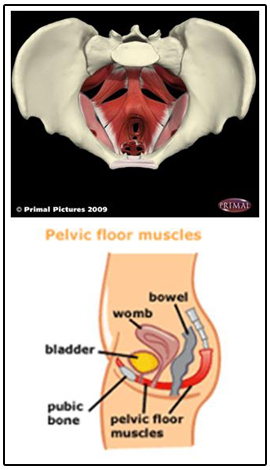
What is Pelvic Floor Muscle Dysfunction?
Pelvic floor muscles, also called the levator ani complex, form the muscular base of the pelvis running from front to back and in from the sides like a hammock. These muscles support the bladder, uterus, vagina, and rectum. They also provide function in maintaining continence, elimination, breathing, intercourse, and low back/pelvic stability. Pelvic floor muscle dysfunction (PFMD) refers to having pain, tension, trigger points, weakness, disuse, or discoordination in the muscles comprising the pelvic floor. There are two categories of pelvic floor muscle dysfunction seen in the literature: overactive pelvic floor muscles (previously known as hypertonicity or high-tone) and underactice (previously known as hypotonicity or low-tone) pelvic floor muscles. Pelvic floor muscles that have a overactive presentation are shortened, painful, have trigger points or tender points, taut bands, higher tension at rest, and may be in spasm. Pelvic floor overactivity was also previously known as levator ani syndrome. Pelvic floor muscle overactivity is related to pelvic pain syndromes such as interstitial cystitis, vulvodynia, fissures, lichens schlerosus, endometriosis, irritable bowel syndrome, chronic pelvic pain, prostatitis, pudendal neuralgia or entrapment, and coccygodynia. It can also be related to hip derangement and sexual or physical trauma. Pelvic floor muscle myofascial trigger points can cause referral of pain to other areas of the pelvis including the suprapubic region, groin, inner thighs, buttock, sacrum, coccyx, rectum/anus, bladder, and vagina. Pelvic floor muscles that have a underactive presentation are weak, lengthened, have low tone or tension at rest, and exhibit poor contractile properties. Pelvic floor muscle underactive is related to urinary or fecal incontinence issues, pelvic organ prolapses, impaired nerve function, disuse, anorgasmia, erectile dysfunction, sedentary lifestyle, low back pain, pelvic instability, generalized hypermobility syndrome, and trauma. Pelvic floor muscle overactivity and underactive dysfunction can result in discoordination and weakness of the pelvic floor muscles because in either scenario the muscles are not properly recruited or contracted due to pain or inhibition and not at normal resting length.
How can Pamela Morrison Physical Therapy, P.C. help with Pelvic floor Muscle Dysfunction?
Your pelvic expert at Pamela Morrison Physical Therapy, P.C. must first correctly diagnose your Pelvic Floor Muscle Dysfunction by taking a thorough history and completing a comprehensive pelvic exam. A prescriptive program is implemented which is personalized for your specific dysfunction since every patient has different issues and histories. For those patients with overactive PFMD, a program may be comprised of pelvic joint mobilization techniques for realignment, modalities for pain such as electrical stimulation including interferential, TENS, cold laser, moist heat, cryotherapy, ultrasound, prescriptive pelvic floor muscle exercises, stretching and strengthening exercises, trigger point release techniques, surface EMG biofeedback, urogenital/visceral mobilization, relaxation training, soft tissue massage/mobilization, neural tension releases, skin rolling, and muscle re-education training. Down-training techniques to lower baseline pelvic floor muscle tone and tension are implemented. Other interventions may include dilator therapy and sexual education. For those patients with underactive PFMD, your program may be comprised of pelvic joint mobilization techniques for realignment, neuromuscular re-education, electrical stimulation, surface EMG biofeedback, stability training, urogenital manipulation, neural tension releases, and prescriptive pelvic floor muscle exercises. Other interventions may include bowel/bladder retraining, dietary changes, instruction on proper body mechanics, pelvic support belts or garments, sexual education, and low back rehab. Use of our state-of-the-art Rehabilitative Real-time Ultrasound can help facilitate improved pelvic floor muscle function quickly. Up-training and overflow techniques to improve pelvic floor muscle recruitment and tone will be implemented. We are experts in the treatment of all types of pelvic floor muscle dysfunction and have successfully treated over 2500 patients since 2001.


